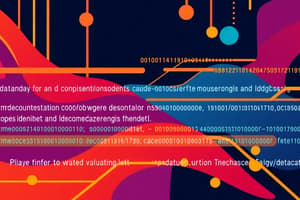Podcast
Questions and Answers
Which of the following describes an organized collection of logically related data designed to store, retrieve, and manage information efficiently?
Which of the following describes an organized collection of logically related data designed to store, retrieve, and manage information efficiently?
- DBMS
- Database (correct)
- Structured Data
- Metadata
What term refers to stored representations of meaningful objects or events?
What term refers to stored representations of meaningful objects or events?
- Data (correct)
- Unstructured Data
- Information
- Structured Data
Which type of data is organized in a predefined format, such as rows and columns in a table?
Which type of data is organized in a predefined format, such as rows and columns in a table?
- Unstructured Data
- Data
- Structured Data (correct)
- Metadata
What is data that describes the properties and context of other data, aiding users in understanding and managing it, referred to as?
What is data that describes the properties and context of other data, aiding users in understanding and managing it, referred to as?
What issue arises when each program using a file must include its own data specifications?
What issue arises when each program using a file must include its own data specifications?
What is the term for the situation where different systems or programs create and maintain separate copies of the same data?
What is the term for the situation where different systems or programs create and maintain separate copies of the same data?
Which challenge do programmers face when they need to design and code file formats and logic for each application from scratch?
Which challenge do programmers face when they need to design and code file formats and logic for each application from scratch?
What issue arises from the lack of standardization, requiring frequent updates to maintain individual programs?
What issue arises from the lack of standardization, requiring frequent updates to maintain individual programs?
Storing the same data in multiple places creates unnecessary storage space which leads to __________ .
Storing the same data in multiple places creates unnecessary storage space which leads to __________ .
When data is duplicated, it becomes harder to update and maintain; this causes __________ .
When data is duplicated, it becomes harder to update and maintain; this causes __________ .
If data changes in one place but not in others, that leads to conflicting or inconsistent information, which results in __________ .
If data changes in one place but not in others, that leads to conflicting or inconsistent information, which results in __________ .
Data redundancy can lead to errors, and this makes it difficult to trust the accuracy of the data, which compromises __________
Data redundancy can lead to errors, and this makes it difficult to trust the accuracy of the data, which compromises __________
Databases require regular backups and plans for recovery in case of failure, and this adds to the operational costs, which means there is a __________
Databases require regular backups and plans for recovery in case of failure, and this adds to the operational costs, which means there is a __________
Moving from an old system to a new database system can require time, effort, and resources to convert the data, and therefore incurs __________.
Moving from an old system to a new database system can require time, effort, and resources to convert the data, and therefore incurs __________.
Implementing a database system can cause conflict within an organization, especially if departments are used to working in their own way, and this generates ___________.
Implementing a database system can cause conflict within an organization, especially if departments are used to working in their own way, and this generates ___________.
What type of database is a small, user-specific database designed to store personal information, often for one person's use?
What type of database is a small, user-specific database designed to store personal information, often for one person's use?
What does it mean for Enterprise Resource Planning (ERP) to be integrated?
What does it mean for Enterprise Resource Planning (ERP) to be integrated?
What type of system involves separating the database from the client (user interface)?
What type of system involves separating the database from the client (user interface)?
What does it mean for a business to have enterprise applications?
What does it mean for a business to have enterprise applications?
What is a large, centralized repository where data from different operational databases is collected, stored, and organized for reporting and decision-making called?
What is a large, centralized repository where data from different operational databases is collected, stored, and organized for reporting and decision-making called?
Flashcards
Database
Database
An organized collection of logically related data, designed to store, retrieve, and manage information efficiently
Data
Data
Stored representations of meaningful objects and events.
Structured Data
Structured Data
Organized in a predefined format, such as rows and columns in a table.
Metadata
Metadata
Signup and view all the flashcards
Program-Data Dependence
Program-Data Dependence
Signup and view all the flashcards
Duplication of Data
Duplication of Data
Signup and view all the flashcards
Lengthy Development Times
Lengthy Development Times
Signup and view all the flashcards
Excessive Program Maintenance
Excessive Program Maintenance
Signup and view all the flashcards
Waste of Space
Waste of Space
Signup and view all the flashcards
Causes More Maintenance Headaches
Causes More Maintenance Headaches
Signup and view all the flashcards
Data Inconsistencies
Data Inconsistencies
Signup and view all the flashcards
Conversion Costs
Conversion Costs
Signup and view all the flashcards
Personal Databases
Personal Databases
Signup and view all the flashcards
Enterprise Resource Planning
Enterprise Resource Planning
Signup and view all the flashcards
Two-Tier and N-Tier Client/Server Databases
Two-Tier and N-Tier Client/Server Databases
Signup and view all the flashcards
Data Warehouse
Data Warehouse
Signup and view all the flashcards
Data Modeling
Data Modeling
Signup and view all the flashcards
Entity
Entity
Signup and view all the flashcards
Attribute
Attribute
Signup and view all the flashcards
Business Rule
Business Rule
Signup and view all the flashcards
Study Notes
Database Fundamentals
- A database is an organized collection of logically related data
- Databases are designed for efficient information storage, retrieval, and management
- Data refers to stored representations of meaningful objects or events
- Structured data is organized in a predefined format, like rows and columns in a table
- Metadata describes the properties and context of data
- Metadata aids users in understanding and managing the data
Data Management Issues
- Program-data dependence arises when each program using a file includes its own metadata
- Duplication of data occurs when different systems or programs maintain separate copies of the same data
- Lack of standardization leads to frequent updates needed for individual programs
- Storing the same data in multiple places results in unnecessary storage space
- Duplication makes data harder to update and maintain
- Data changes in one file but not in others causes conflicting/inconsistent information
- Redundancy can lead to errors and difficulties in trusting data accuracy
- Databases need regular backups and recovery plans, increasing operational costs
- Moving from an old to a new database system requires time, effort, and resources
- Implementing a database system can cause organizational conflict
Database Types and Systems
- A personal database is a small, user-specific database for storing personal information
- Enterprise Resource Planning (ERP) integrates major business functions using a centralized database
- Two-tier and N-tier client/server databases separate the database and client (user interface)
- Enterprise applications are large-scale and handle various business operations, often using databases
- A data warehouse is a large, centralized repository for reporting and decision-making
- Data warehouses collect, store, and organize information from operational databases
Database Design and Modeling
- Data modeling is the first step in database design, bridging real-world objects and the computer database
- Data models are used in the database design phase and offer graphical representations of data structures
- An entity is a person, place, thing, or event that data is collected and stored about
- An attribute is a characteristic of an entity and corresponds to fields in file systems
- A relationship describes associations between entities (one-to-many, many-to-many, one-to-one)
- A business rule is a brief, precise, and unambiguous description of a policy within an organization
Database Models
- End users are crucial contributors to the development of business rules
- The hierarchical model was developed in the 1960s for managing large amounts of data, represented as an upside-down "tree"
- The network model represents complex data relationships and improves database performance
- A segment is an equivalent of a file system's record type
- A schema is the conceptual organization of the entire database from the database administrator's view
- A subschema defines the portion of the database that application programs can access
- Data Manipulation Language (DML) defines the environment for managing and using data
- Schema Data Definition Language (DDL) allows the database administrator to define schema components
Database Notations
- Chen Notation represents relationships with a diamond connected to related entities
- Crow's Foot Notation uses symbols to represent connectivities (e.g., "1" for a short line, "M" for a three-pronged foot)
Modern Database Concepts
- Extensible Markup Language (XML) is the standard protocol for data exchange
- Inheritance is the ability of an object to inherit attributes/methods from classes above it
- The relational model was a major breakthrough that replaced standard transmission databases
- The Entity Relationship Model is widely accepted for data modeling; introduced by Chen in 1976
- The Enhanced Entity Relationship Model (EERM) adds semantic constructs to the original ER model
Entity Relationships
- Entity Supertype contains common characteristics and is related to subtypes with unique characteristics
- Relationships within the specialization hierarchy are "is-a" relationships
- Inheritance enables an entity subtype to inherit attributes/relationships of the supertype
- A Subtype Discriminator determines which subtype a supertype occurrence is related to
- A disjoint constraint is a subtype containing a unique subset of the supertype entity set
- An overlapping constraint is a subtype with nonunique subsets of the supertype entity set
- Completeness Constraint specifies if each supertype occurrence must be a member of at least one subtype
- Partial completeness means not every supertype occurrence is a member of a subtype
- Total completeness means every supertype occurrence must be a member of at least one subtype
- Specialization is the top-down process of identifying specific entity subtypes from a supertype
- Generalization is the bottom-up process of identifying a higher-level entity supertype from subtypes
- Entity Clustering combines multiple interrelated entities into an abstract object
- A Primary Key guarantees entity integrity and database implementation efficiency
Keys and Data Management
- Natural keys are real-world identifiers used to uniquely identify objects
- Composite Primary Keys identify composite entities where each key combination is unique
- Surrogate Primary Keys are designer-created keys to simplify entity identification
- Foreign keys work with primary keys to implement relationships
- Implementing 1:1 Relationships involves using foreign keys with primary keys
- Maintaining History of Time-Variant Data manages data changes
- Fan Traps occur when entities have two 1:M relationships producing unintended associations
- Redundant Relationships should remain consistent across the model
Big Data and Database Roles
- Big Data is finding new methods to manage large amounts of web and sensor-generated data
- Database Designers reconcile differences and verify business rules
- The Model helps in understanding the complexities
- Relational Database Management Systems perform functions provided by the hierarchical model
- Object-Oriented Data Models serve as the basis for OODBMS and are semantic
- CASE Tools are software tools that help design and develop databases
- A Repository stores all metadata, describing the structure, relationships, and properties
- Database Management Systems manage and control access to the database
- Data/Database Administrators maintain the database
- System Developers design and create the database
- Specialization provides means to support attribute inheritance
- Entity subtypes inherit all relationships
- Primary key's function is to guarantee entity integrity
- Entity Clusters cause the key attributes of combined entities to be unavailable
- Primary Key guarantees integrity
Studying That Suits You
Use AI to generate personalized quizzes and flashcards to suit your learning preferences.




